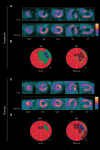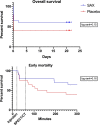Myocardial perfusion recovery induced by an α-calcitonin gene-related peptide analogue
- PMID: 34089154
- PMCID: PMC9553834
- DOI: 10.1007/s12350-021-02678-8
Myocardial perfusion recovery induced by an α-calcitonin gene-related peptide analogue
Abstract
Background: Endogenous calcitonin gene-related peptide (CGRP) induces cardioprotective effects through coronary vasodilation. However, the systemic administration of CGRP induces peripheral vasodilation and positive chronotropic and inotropic effects. This study aims to examine the net effect on coronary perfusion of the systemically administered α-calcitonin gene-related peptide analogue, SAX, in rats during myocardial infarction.
Methods: Forty Sprague-Dawley rats underwent myocardial infarction. Following left anterior descending artery occlusion, [99mTc]Tc-sestamibi was administered to determine the myocardial perfusion before treatment. Twenty minutes, 24 and 48 h after [99mTc]Tc-sestamibi injection, the rats were treated with either SAX or placebo. Final infarct size was determined three weeks later by [99mTc]Tc-sestamibi SPECT/CT scan.
Results: Thirty-one rats survived the surgery and 20 completed the follow-up SPECT/CT scan (SAX n = 12; Placebo n = 8). At baseline, there was no difference in size of perfusion defect between the groups (P = .88), but at follow-up the SAX group had improved myocardial recovery compared to the placebo group (P = .04), corresponding to a relative perfusion recovery of 55% in SAX-treated rats.
Conclusion: The CGRP analogue, SAX, has a cardioprotective effect in this rat model of myocardial infarction, improving myocardial perfusion recovery after chronic occlusion of the coronary artery.
Keywords: MPI; Myocardial ischemia and infarction; Physiology of myocardial/coronary perfusion; SPECT.
© 2021. The Author(s).
Figures





Comment in
-
Calcitonin gene-related peptide (CGRP)-induced recovery after myocardial infarction: Is there a role for CGRP-targeted molecular image-guided strategies in cardiology?J Nucl Cardiol. 2022 Oct;29(5):2100-2102. doi: 10.1007/s12350-021-02686-8. Epub 2021 Jun 4. J Nucl Cardiol. 2022. PMID: 34089153 Free PMC article. No abstract available.
Similar articles
-
Comparison of single-photon emission computed tomographic (SPECT) myocardial perfusion imaging with thallium-201 and technetium-99m sestamibi in dogs.J Am Coll Cardiol. 1992 Dec;20(7):1612-25. doi: 10.1016/0735-1097(92)90458-y. J Am Coll Cardiol. 1992. PMID: 1452936
-
Separate acquisition rest thallium-201/stress technetium-99m sestamibi dual-isotope myocardial perfusion single-photon emission computed tomography: a clinical validation study.J Am Coll Cardiol. 1993 Nov 1;22(5):1455-64. doi: 10.1016/0735-1097(93)90557-h. J Am Coll Cardiol. 1993. PMID: 8227805 Clinical Trial.
-
Myocardial contractile reserve and perfusion defect severity with rest and stress dobutamine (99m)Tc-sestamibi SPECT in canine stunning and subendocardial infarction.J Nucl Med. 2002 Apr;43(4):540-50. J Nucl Med. 2002. PMID: 11937600
-
Myocardial perfusion imaging with technetium-99m sestamibi SPECT in the evaluation of coronary artery disease.Am J Cardiol. 1990 Oct 16;66(13):55E-62E. doi: 10.1016/0002-9149(90)90613-6. Am J Cardiol. 1990. PMID: 2145748 Review.
-
Application of technetium-99m sestamibi single photon emission computed tomography in acute myocardial infarction: measuring the efficacy of therapy.Q J Nucl Med Mol Imaging. 2010 Apr;54(2):213-29. Q J Nucl Med Mol Imaging. 2010. PMID: 20588215 Review.
Cited by
-
Alpha-Calcitonin Gene Related Peptide: New Therapeutic Strategies for the Treatment and Prevention of Cardiovascular Disease and Migraine.Front Physiol. 2022 Feb 11;13:826122. doi: 10.3389/fphys.2022.826122. eCollection 2022. Front Physiol. 2022. PMID: 35222088 Free PMC article. Review.
-
CGRP physiology, pharmacology, and therapeutic targets: migraine and beyond.Physiol Rev. 2023 Apr 1;103(2):1565-1644. doi: 10.1152/physrev.00059.2021. Epub 2022 Dec 1. Physiol Rev. 2023. PMID: 36454715 Free PMC article. Review.
-
CGRP inhibits SARS-CoV-2 infection of bronchial epithelial cells, and its pulmonary levels correlate with viral clearance in critical COVID-19 patients.J Virol. 2024 Sep 17;98(9):e0012824. doi: 10.1128/jvi.00128-24. Epub 2024 Aug 20. J Virol. 2024. PMID: 39162434 Free PMC article.
-
The Vascular-Dependent and -Independent Actions of Calcitonin Gene-Related Peptide in Cardiovascular Disease.Front Physiol. 2022 Feb 25;13:833645. doi: 10.3389/fphys.2022.833645. eCollection 2022. Front Physiol. 2022. PMID: 35283798 Free PMC article. Review.
-
Calcitonin gene-related peptide (CGRP)-induced recovery after myocardial infarction: Is there a role for CGRP-targeted molecular image-guided strategies in cardiology?J Nucl Cardiol. 2022 Oct;29(5):2100-2102. doi: 10.1007/s12350-021-02686-8. Epub 2021 Jun 4. J Nucl Cardiol. 2022. PMID: 34089153 Free PMC article. No abstract available.
References
-
- O’Connor RE, Brady W, Brooks SC, Diercks D, Egan J, Ghaemmaghami C, et al. Part 10: Acute coronary syndromes: 2010 American Heart Association Guidelines for Cardiopulmonary Resuscitation and Emergency Cardiovascular Care., Circulation 2010;122. - PubMed
Publication types
MeSH terms
Substances
LinkOut - more resources
Full Text Sources
Other Literature Sources
Medical
Research Materials

